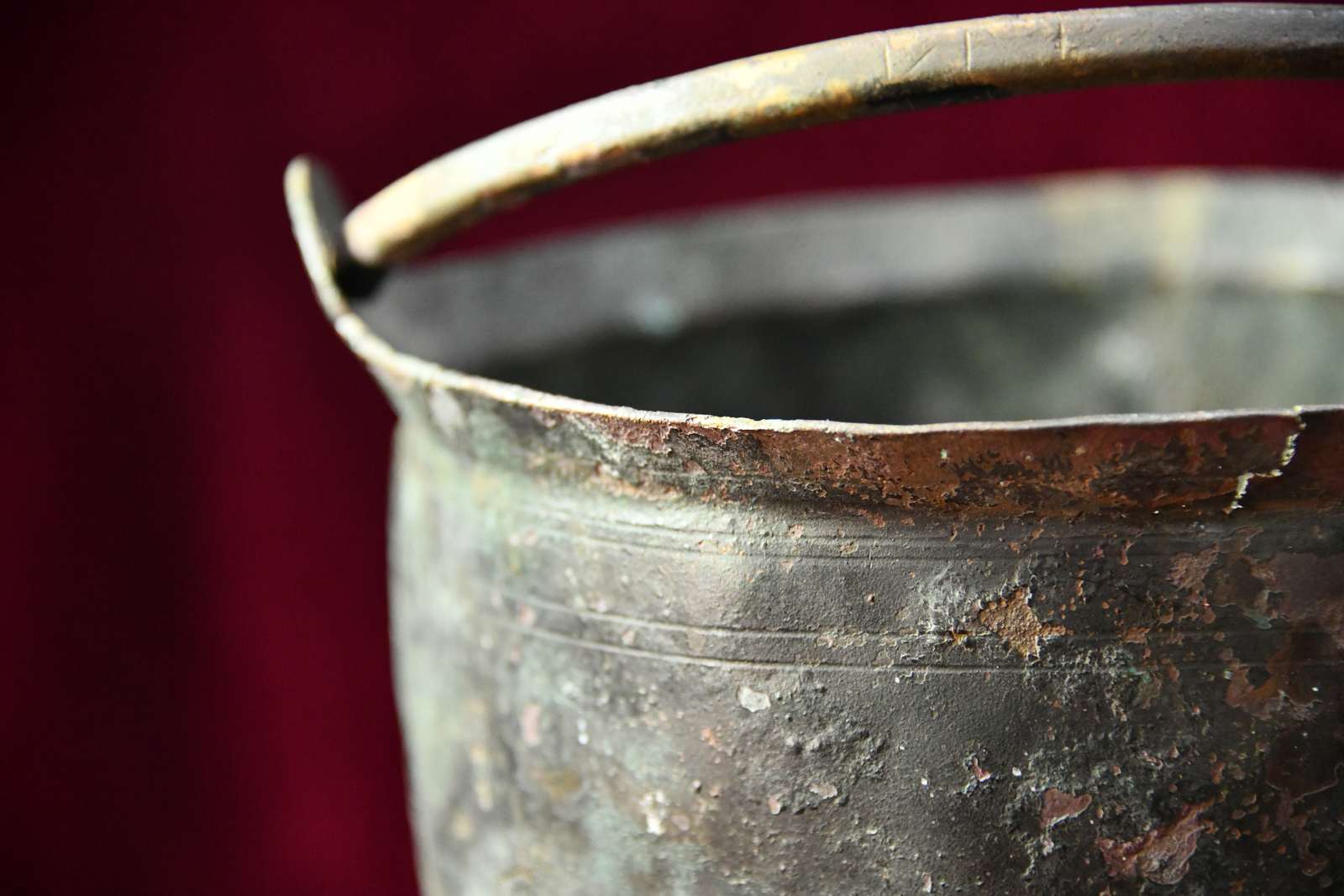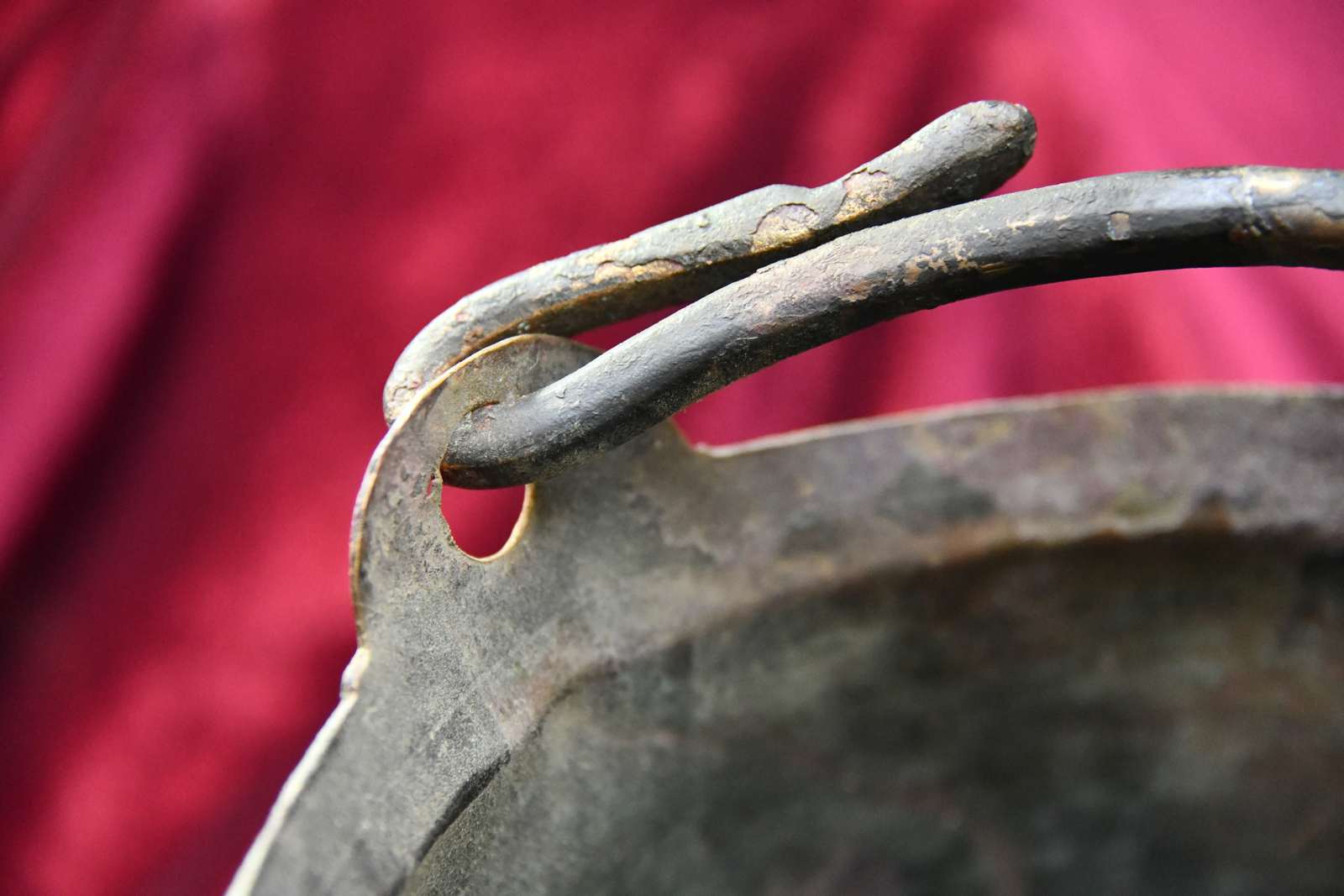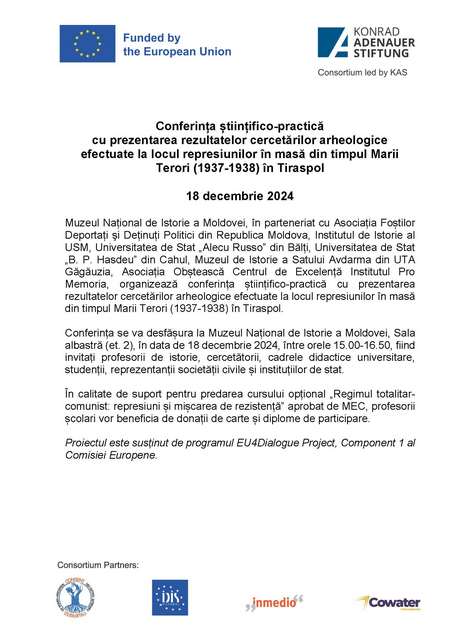  #Exhibit of the Month #Exhibit of the Month
September 2024
The Metal Vessel from Yahorlyk on the Middle Dniester

The metal vessel was likely used as a funerary urn. It was found together with another vessel, shaped like a shell and used as a lid for the urn, in a landslide along the road within the Yahorlyk Nature Reserve, Dubăsari District. The village of Yahorlyk is located at the mouth of the stream of the same name, a left tributary of the Dniester River.
The vessel belongs to the Hemmoo type (or Eggers 63) and is a rare find in the late ancient sites of the 2nd-3rd centuries AD. Researchers consider this type of vessel to be of Italic, Gallo-Italic, or Mediterranean origin, frequently used as a funerary urn or burial inventory by the Bastarnae. Upon discovery, the vessel was reportedly filled with "earth and burnt bones." The vessel was found together with a brass sheet vessel that had undulated or fluted walls. It has a height of 14.9 cm (without the base ring). The diameter of the vessel's body is 19.5 cm, and the total height is 16.2 cm. The rim of the vessel flares outward with a diameter of 20.5 cm. The vessel is made from thin brass sheet, only 0.1 cm thick. The upper part of the vessel is modestly ornamented. The middle of the rim, on the exterior, has a shallow horizontal line incised. The transition from the rim to the body is marked by a wide groove, 0.3 cm in width. From this groove, the rim thickens to 0.25 cm. On the upper part of the rim, on two symmetrically placed sides, semicircular handles with stepped bases were cut out. The handles are 2.2 cm in height and 5.1 cm in width. Including the "steps" at the base, the handles are 6.1 cm wide. In the middle of each handle, a circular elongated hole was made for the attachment of a handle, measuring 1.2 x 1.5 cm. The vessel was found together with a brass sheet vessel that had undulated or fluted walls. It has a height of 14.9 cm (without the base ring). The diameter of the vessel's body is 19.5 cm, and the total height is 16.2 cm. The rim of the vessel flares outward with a diameter of 20.5 cm. The vessel is made from thin brass sheet, only 0.1 cm thick. The upper part of the vessel is modestly ornamented. The middle of the rim, on the exterior, has a shallow horizontal line incised. The transition from the rim to the body is marked by a wide groove, 0.3 cm in width. From this groove, the rim thickens to 0.25 cm. On the upper part of the rim, on two symmetrically placed sides, semicircular handles with stepped bases were cut out. The handles are 2.2 cm in height and 5.1 cm in width. Including the "steps" at the base, the handles are 6.1 cm wide. In the middle of each handle, a circular elongated hole was made for the attachment of a handle, measuring 1.2 x 1.5 cm.
 The ornamentation on the upper part of the vessel's body consists of two bands, each formed by two parallel incised lines, spaced 0.2 to 0.4 cm apart. The interval between the two bands is 0.9 cm. The vessel's handle is semicircular, mobile, fairly thick, rectangular in cross-section (0.8 x 0.9 cm), and made from a rounded brass bar. The ends of the handle are thinned to 0.6 cm and widened to 0.9 cm over a length of 2.6 cm, resembling bird heads. On the median part of the bar, incised marks resembling Roman numerals IX and XI are present. The bottom of the vessel was made from a separate brass sheet, worked by pressing on a lathe. Evidence of this process is the indentation from the lathe's fixing rod, preserved in the central part of the vessel's bottom. Surrounding this indentation is an ornament consisting of two bands of concentric lines, with diameters of 1.8 cm and 5.9 cm, respectively. The lower part of the vessel is raised and rests on a ringed base, formed by shaping the vessel's walls and bending the piece that formed the actual bottom. This base has a diameter of 8.7 cm. For the North-West Pontic and East-Carpathian regions, several scattered sites or points where fragments of metal vessels were discovered, used as funerary inventory or urns, should be mentioned. These include discoveries from the funerary complexes of flat necropolises dated to the first centuries AD, at Hansca-Lutăria II and Dănceni-Ialoveni. Here, excavations identified noble graves with fragments of bronze vessels with metal handles, similar to the vessel from Yahorlyk.
|


















































